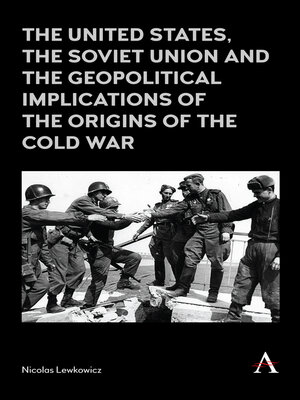The United States, the Soviet Union and the Geopolitical Implications of the Origins of the Cold War
ebook
By Nicolas Lewkowicz

Sign up to save your library
With an OverDrive account, you can save your favorite libraries for at-a-glance information about availability. Find out more about OverDrive accounts.
Find this title in Libby, the library reading app by OverDrive.



Search for a digital library with this title
Title found at these libraries:
| Library Name | Distance |
|---|---|
| Loading... |
'The United States, the Soviet Union and the Geopolitical Implications of the Origins of the Cold War, 1945–1949' describes how the United States and the Soviet Union deployed their hard and soft power resources to create the basis for the institutionalization of the international order in the aftermath of World War Two. The book argues that the origins of the Cold War should not be seen from the perspective of a magnified spectrum of conflict but should be regarded as a process by which the superpowers attempted to forge a normative framework capable of sustaining their geopolitical needs and interests in the post-war scenario.
'The United States, the Soviet Union and the Geopolitical Implications of the Origins of the Cold War, 1945–1949' examines how the use of ideology and the instrument of political intervention in the spheres of influence managed by the superpowers were conducive to the establishment of a stable international order. It postulates that the element of conflict present in the early period of the Cold War served to demarcate the scope of manoeuvring available to each of the superpowers and studies the notion that the United States and the Soviet Union were primarily interested in establishing the conditions for the accomplishment of their vital geostrategic interests. This required the implementation of social norms imposed in the respective spheres of influence, a factor that provided certainty to the spectrum of interstate relations after the period of turmoil that culminated with the onset of World War Two.
|'The United States, the Soviet Union and the Geopolitical Implications of the Origins of the Cold War, 1945–1949' postulates that the geopolitical interests and needs of the superpowers led to the configuration of the post-war international order. Taking a long-term approach to the evolution of the system of states, it describes how the United States and the Soviet Union deployed their hard and soft power resources to create the basis for the institutionalization of the international order in the aftermath of World War Two. The main idea advanced by this book is that the origins of the Cold War should not be seen from the perspective of a magnified spectrum of conflict but should be regarded as a process by which the superpowers attempted to forge a normative framework capable of sustaining their geopolitical needs and interests in the post-war scenario. This book examines how the use of ideology and the instrument of political intervention in the spheres of influence managed by the superpowers was conducive to the establishment of a stable international order.
'The United States, the Soviet Union and the Geopolitical Implications of the Origins of the Cold War, 1945–1949' postulates that the element of conflict present in the early period of the Cold War served to demarcate the scope of manoeuvring available to each of the superpowers. This state of affairs denotes the existence of diverging geopolitical interests, acknowledged through the presence of well-demarcated spheres of influence. The book examines the notion that the United States and the Soviet Union were primarily interested in establishing the conditions for accomplishing their vital geostrategic interests, which required the implementation of social norms imposed in the respective spheres of influence, a factor that provided certainty to the spectrum of interstate relations after the period of turmoil that culminated in the outbreak of World War Two. Drawing on the example of the friction that affected Soviet-American relations at the end of World War Two, this book examines the circumstances that give rise to the construction of sound...







